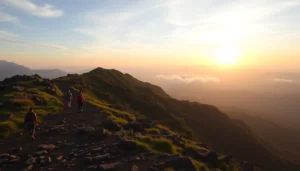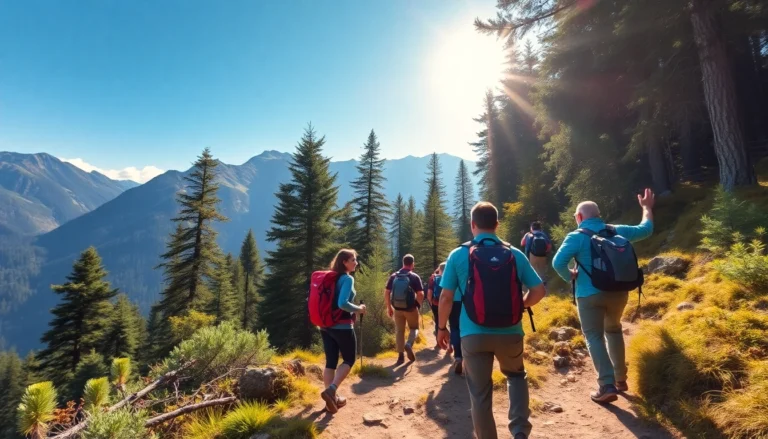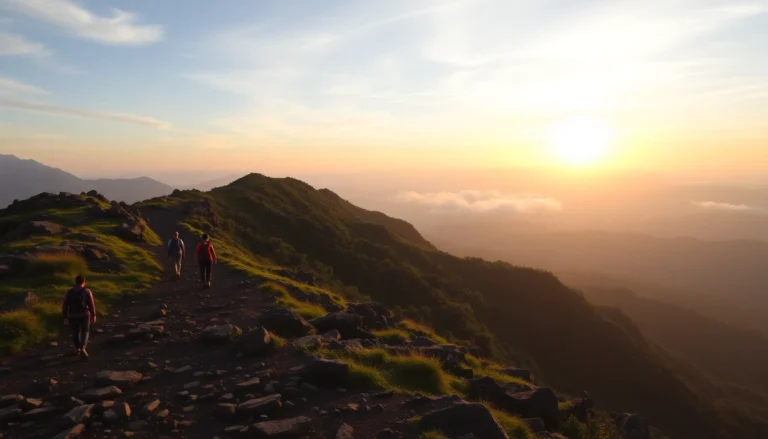Introduction to Trekking in Indonesia
Indonesia, renowned for its breathtaking landscapes and rich biodiversity, has become a prime destination for outdoor enthusiasts seeking authentic and challenging adventure experiences. Among these pursuits, trekking stands out as a captivating way to explore the country’s diverse terrains, from towering mountains and lush rainforests to remote villages and pristine waterfalls. Whether you’re an experienced hiker or a novice adventurer, trekking in Indonesia offers a unique opportunity to connect deeply with nature, immerse yourself in local cultures, and attain physical and mental well-being. This comprehensive guide aims to equip prospective trekkers with essential knowledge, practical tips, and inspiring insights to make the most of their Indonesian trekking journey.
What Makes Indonesia a Top Trekking Destination
Indonesia’s appeal as a top trekking destination lies in its unparalleled natural diversity and cultural richness. The archipelago comprises over 17,000 islands, each boasting distinct landscapes, ecosystems, and communities. This vast geographic spread provides countless trekking routes suitable for all levels of experience, from gentle nature walks to multi-day expeditions across rugged terrains.
Some of the world’s most iconic trekking destinations are found in Indonesia, including the volcanic peaks of Krakatoa, the mystical jungles of Sumatra, and the legendary volcanoes of Java like Mount Bromo and Mount Rinjani. In addition, Bali’s lush rice terraces, Sulawesi’s karst mountains, and Lombok’s extraordinary Gunung Rinjani offer diverse terrains that attract thousands of trekking enthusiasts annually. Moreover, Indonesia’s warm hospitality, combined with vibrant local cultures and traditions, enhances the overall trekking experience, transforming it into an immersive adventure that goes beyond physical exertion.
With varied climate zones and ecosystems, Indonesia presents an ideal playground for eco-tourism and adventure tourism. The country is committed to conservation efforts and sustainable tourism, ensuring that trekking activities contribute positively to local communities and preserve the natural environment for future generations.
Understanding the Basics of Trekking
What is Trekking?
Trekking refers to a long, vigorous hike in a wild natural environment, often spanning multiple days and usually involving off-trail exploration. It typically requires physical endurance, mental resilience, and proper planning. Unlike casual hiking, which is usually a short walk on well-maintained trails, trekking includes traversing rugged, sometimes remote terrains, often with overnight stays in tents, huts, or local guesthouses.
The emphasis in trekking is on experiencing nature at an immersive level—walking through forests, crossing mountain passes, and navigating diverse landscapes that challenge both body and mind. It often involves a higher level of preparation, including route planning, logistical arrangements, and physical conditioning, making it a rewarding pursuit for adventure seekers looking for meaningful and transformative journeys.
Difference Between Trekking and Hiking
While the terms “trekking” and “hiking” are frequently used interchangeably, they differ significantly in scope, duration, and difficulty. Hiking generally pertains to shorter, less complex walks primarily on established trails, often completed within a single day. It is accessible to most and requires minimal equipment.
In contrast, trekking involves extended journeys that may last several days, covering long distances over varied and often challenging terrains. Trekking demands careful planning for accommodations, supplies, and safety measures. It necessitates increased physical fitness and sometimes technical skills, especially when navigating elevation changes, river crossings, or remote areas with limited access to help.
Understanding these distinctions is crucial for planning appropriate adventures and setting realistic expectations. Whether you choose a leisurely hike or a multi-day trek, both activities promote physical health, mental clarity, and a profound appreciation of nature.
The Significance of Trekking in the Indonesian Context
In Indonesia, trekking is more than a recreational activity; it is a way to foster environmental awareness and cultural respect. Many routes are intertwined with local traditions and histories, offering insights into indigenous lifestyles and spiritual practices. Properly engaging with these elements enhances the authenticity of trekking experiences and promotes sustainable tourism practices.
Popular Trekking Spots Overview
Indonesia offers an array of world-class trekking destinations, each with unique features that cater to different interests and skill levels. Below are some of the most popular trekking spots across the archipelago:
1. Mount Rinjani, Lombok
As Indonesia’s second-highest volcano, Mount Rinjani stands at 3,726 meters and is famed for its stunning crater lake and panoramic views. The Rinjani Trek typically takes 2-3 days, with trekkers traversing diverse terrains including lush forests, hot springs, and volcanic ash fields. The ascent offers a sense of achievement and awe, especially at the summit during sunrise.
2. Mount Bromo, East Java
Known for its otherworldly volcanic landscape, Mount Bromo provides an accessible yet exhilarating trekking experience. Visitors often arrive before dawn to witness the sunrise over the sea of sand and the active crater. The trek involves walking across the volcanic terrain, often combined with a visit to nearby sites like the Teletubbies Hills.
3. Kerinci Seblat National Park, Sumatra
This UNESCO-protected park is home to Gunung Kerinci, the highest volcano in Indonesia, and a biodiverse rainforest ecosystem. Trekking here typically involves multi-day excursions through dense jungles, spotting wildlife such as orangutans, and exploring waterfalls and hot springs. It’s a paradise for nature lovers and adventure travelers alike.
4. Cinque Terre-inspired Landscapes in Bali
Bali’s rice terraces and mountain villages like Munduk and Campuhan offer less strenuous, scenic hikes. These routes showcase vibrant terraced fields, waterfalls, and traditional Balinese culture, making them ideal for leisurely treks that combine nature with cultural immersion.
5. Glamping and Trekking in Sulawesi
With challenging terrains such as karst mountains and remote forests, trekking in Sulawesi often includes cave explorations, river crossings, and wildlife encounters. These adventures combine rugged outdoor activities with local hospitality, attracting seasoned trekkers.
Planning Your Trekking Adventure
Choosing the Right Trekking Route
Selecting an appropriate route depends on your experience, physical fitness, and interests. Beginners might opt for scenic day hikes around accessible destinations like Bali’s rice terraces or Mount Bromo. Experienced trekkers seeking a challenge may explore multi-day expeditions to Rinjani or Kerinci.
Factors to consider include trail difficulty, altitude, climate conditions, required permits, and logistical considerations such as transportation and accommodation. Consulting local guides and tour operators ensures route suitability and safety. Researching user reviews and expert recommendations provides valuable insights into current trail conditions and challenges.
Essential Gear and Preparation Tips
Proper preparation is fundamental to successful trekking. Essential gear includes high-quality hiking boots, moisture-wicking clothing, a lightweight backpack, navigation tools (maps, compass, GPS), and safety equipment such as first aid kits, headlamps, and weather protection.
Pre-trip training focusing on cardiovascular endurance, strength, and flexibility enhances physical readiness. Acclimatization to altitude and weather conditions helps prevent altitude sickness or heat-related illnesses. Developing a detailed packing list based on trek duration, conditions, and personal needs is crucial.
Practical preparation also involves logistical planning—securing permits, arranging transportation, booking accommodations, and preparing emergency contacts. Engaging with seasoned guides or trekking agencies can streamline these processes and maximize safety and enjoyment.
Safety and Environmental Considerations
Ensuring safety involves a combination of careful planning, awareness, and adherence to local regulations. Always inform someone about your itinerary, carry communication devices, and understand emergency procedures. Recognize signs of altitude sickness, dehydration, or fatigue and take appropriate actions.
Environmental stewardship is vital. Follow Leave No Trace principles by minimizing waste, respecting wildlife, staying on designated trails, and avoiding damaging flora. Supporting community-based tourism initiatives helps local economies and promotes sustainable practices.
Trekking Techniques and Skills
Navigation and Trail Reading
Proficiency in navigation is vital, especially in remote areas with poorly marked trails. Use a combination of topographic maps, digital GPS devices, and compass skills to stay oriented. Recognizing natural landmarks such as mountain peaks, rivers, and distinctive vegetation aids trail reading.
Learning to interpret trail markers and signs, understanding compass bearings, and using GPS devices accurately enhance safety and confidence. In unfamiliar terrains, always plan alternate routes and be prepared for sudden changes in weather.
Physical Conditioning for Trekking
Building endurance and strength through targeted training ensures you are physically prepared for demanding routes. Cardiovascular exercises like running, cycling, or swimming improve stamina. Leg-strengthening workouts (squats, lunges) prepare you for elevation gains.
Incorporate practical hikes with loaded backpacks and varied terrains to simulate real trekking conditions. Flexibility exercises, core strengthening, and balance training reduce injury risks and increase overall resilience.
Teamwork and Mental Resilience
Effective communication, cooperation, and leadership are key for group safety and success. Cultivating mental resilience—maintaining a positive attitude, managing stress, and adapting to unforeseen challenges—makes trekking more enjoyable.
Practicing mindfulness, setting realistic goals, and developing problem-solving skills prepare trekkers to face unpredictable situations. Building camaraderie within the group fosters trust and motivation throughout the journey.
Experiencing Local Culture and Nature
Wildlife and Flora of Indonesian Trails
Indonesia’s rich biodiversity is one of its greatest attractions. Trekkers can encounter unique flora such as orchids and rhododendrons, and observe wildlife including orangutans, hornbills, and various endemic species. Many national parks and protected areas serve as habitats for endangered species, emphasizing the importance of conservation awareness during trekking activities.
Respecting Local Communities
Engaging respectfully with local communities enriches the trekking experience. Always seek permission before entering villages, participate in community-led tourism initiatives, and support local artisans and businesses. Understanding cultural norms and traditions fosters mutual respect and sustainable tourism development.
Capturing Your Trekking Memories
Preserving the journey through photography, journaling, or digital storytelling enhances your adventure. Early mornings and sunset hours provide optimal lighting for landscapes and portraits. Respect natural and cultural sites by minimizing disturbance while capturing memorable moments.
Advanced Trekking Tips and Resources
Long-term Trekking Planning
For extensive or multi-month treks, meticulous planning is essential. Create detailed itineraries, arrange permits, and secure support logistics such as guides, porters, and supplies. Build up physical fitness gradually and schedule acclimatization days to prevent altitude issues.
Establish contingency plans for unexpected events like injury, weather changes, or route closures. Invest in quality gear and consider travel insurance that covers adventure activities.
Training Programs and Workshops
Participate in pre-trek training programs focusing on technical skills such as navigation, first aid, and environmental conservation. Workshops can also enhance cultural understanding and language skills, facilitating better interactions with local communities.
Recommended Trekking Equipment Brands
Selecting reliable gear from reputable brands ensures durability and safety. Popular choices include The North Face, Merrell, Columbia, Petzl, and MSR. Invest in high-quality footwear, weather protection, and hydration systems tailored to Indonesian climate conditions, especially humid forests and high-altitude environments.







